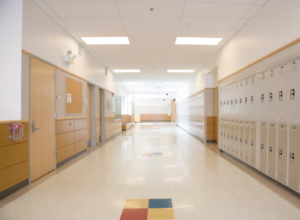
January 5, 2024
School Protests and Free Speech: Legal Considerations for School Districts
By Sarah Mack
School district clients reach out to us with increasing frequency about how to handle walkouts, protests, and other demonstrations by students, staff, and community members, without stumbling into free speech violations. As public education experts have noted, schools across the country have experienced an uptick in political and cultural conflict in recent years, and school districts are frequently in the news for their responses.
With an election year on the horizon, two major wars dominating the headlines, and social media fueling heated cultural debate, school districts face increased pressure to balance the free speech rights of students, staff, and their wider communities with their educational responsibilities.
Below are a few guidelines for school administrators to keep in mind as they navigate these issues.
Student Speech
Students generally have the right to speak out, hand out flyers and petitions, and wear expressive clothing in school, as long as they don’t disrupt the functioning of the school or violate school policies that don’t hinge on the message expressed. What counts as “disruptive” will vary by context, but a school disagreeing with a student’s position or thinking the student’s speech is controversial or in “bad taste” is not enough. Courts have upheld students’ rights to speak outside of school, including on their own social media pages, when there is no evidence of substantial disruption of a school activity or threatened harm to the rights of others. Students also may wear things like an armband opposing the right to get an abortion or a shirt supporting the LGBTQ+ community.
Schools can have rules that have nothing to do with the message being expressed, such as dress codes. For example, a school can prohibit students from wearing hats, when that rule is not based on what the hats say, but they can’t prohibit a student from wearing a hat bearing a political slogan that the District does not agree with while allowing other students to wear hats with messages that are supported.
Likewise, outside of school, students enjoy essentially the same rights to protest and speak out as anyone else. This means students are likely to be most protected if they organize, protest, and advocate for their views off campus and outside of school hours. Individual students and student organizations may also meet in school rooms or auditoriums, or at outdoor locations on school grounds, to discuss, pass resolutions and take other lawful action respecting any matter which directly or indirectly concerns or affects them, whether or not it relates to school. Similarly, students have the right to express opinions on social media, and a school cannot punish the student for content posted off-campus and outside of school hours that does not relate to school. This does not mean off-campus speech cannot be regulated at all. Districts may regulate off-campus speech when it causes a substantial disruption to the educational environment. What constitutes a substantial disruption will be fact specific, so any proposed regulation should be discussed with your legal counsel.
Further, while on campus, students are not entitled to speak without any limitation, and districts may address student expression through policy and procedure, including:
- Encouraging students’ verbal and written expression of opinion on school premises so long as it does not substantially disrupt the operation of the school or otherwise violate district policy or procedure;
- Prohibiting students from the use of vulgar and/or offensive terms in classroom or assembly settings; and
- Predetermining the locations and times for student expression or distribution of publications at schools so as to maintain order and safety on the school campus, to avoid interference with school operations, and to avoid obstructing the ingress to and egress from school facilities or school roadways.
In addition, districts may adopt procedures that outline when speech will be restricted, specific speech prohibitions and the potential for discipline, including when speech impinges on others’ rights, is lewd and obscene, incites the commission of unlawful acts, or is libelous or slanderous.
The Washington State School Directors’ Association (WSSDA), a Washington State agency supporting the State’s locally-elected school board directors, provides model policies and procedures to school districts on many different topics, including freedom of expression, freedom of association and religious freedom.
In addition, First Amendment issues are often nuanced and context-specific, so you should consult with your legal counsel if you have questions.
Employee Speech
While speech is generally protected by the First Amendment, there are many limitations on k-12 teachers and staff. Generally, the First Amendment protects employees’ speech if they are speaking as a private citizen on a matter of public concern. However, what employees say or communicate inside the classroom is considered speech on behalf of the school district and therefore is generally not entitled to First Amendment protection.
Certain types of speech outside the school also might not be protected if the school can show that the speech created a substantial adverse impact on school functioning or that the speech was made in accordance with employees’ job duties.
When it comes to discussing controversial topics in the classroom, districts may adopt policies that govern such discussions, including that:
- The instructional program shall respect the right of students to face issues, to have free access to information, to study under teachers in situations free from prejudice, and to form, hold, and express their own opinions without personal prejudice or discrimination;
- Such discussion shall be guided by teachers with thoroughness and objectivity to acquaint students with the need to recognize opposing viewpoints, the importance of fact, the value of judgment, and the virtue of respect for conflicting opinions; and
- When controversial speakers or programs are presented, reasonable opportunity be given to proponents of opposing points of view to express their side of the question.
With respect to other types of speech, the issues are often murky. For example, let’s suppose that teachers are instructed not to discuss with students their personal opinions on political matters. In a classroom discussion on gay marriage in America, a teacher lets their students know that they have recently participated in several LGBTQ+ demonstrations in support of marriage equality. Such “speech” may not be protected. Courts have found that teachers can be disciplined for departing from the curriculum adopted by the school district, and this may be considered to be such a departure. But the inquiry will be very fact-specific.
Community Speech
While speech by community members is generally protected, there are limitations on community speech in the school setting. This will generally depend on the type of forum created by the district. For example, districts can adopt policies pertaining to the distribution of materials to students and parents, and may choose to make information available about non-profit programs so long as doing so does not interfere with the educational process. However, if they choose to do so, those communications must contain an express disclaimer that the school and the school district do not endorse or sponsor the organization promoting the activity.
Districts may also adopt policies and procedures for the distribution of other types of materials, such as bibles or other religious materials, on campus. Courts have ruled that public schools may require permits or other advance permission to distribute such materials, even when a person distributes the materials on public sidewalks adjacent to school property under certain circumstances. Courts have also ruled that social media sites used to carry out official duties of the district that permit public comment are limited on the types of restrictions that can be placed on public speech. Any restrictions on speech in such public fora must be appropriately tailored to serve a significant governmental interest.
By understanding the unique free speech rights of different constituent groups, and adopting policies and procedures that encourage constructive expression and debate, school districts can position themselves to effectively navigate the current political and cultural environment. Yet it is also important to understand that First Amendment issues are not always clear, and addressing speech by any person or group of people will require a fact-specific inquiry and knowledge of the current law.
For questions about free speech rights, reach out to Sarah Mack or any member of our School Districts practice group.
Click here to download a PDF of this article.
This article is for informational purposes and does not provide legal advice. It is not intended to be used or relied upon as legal advice in connection with any particular situation or facts. The information herein is provided as of the date it is written.


